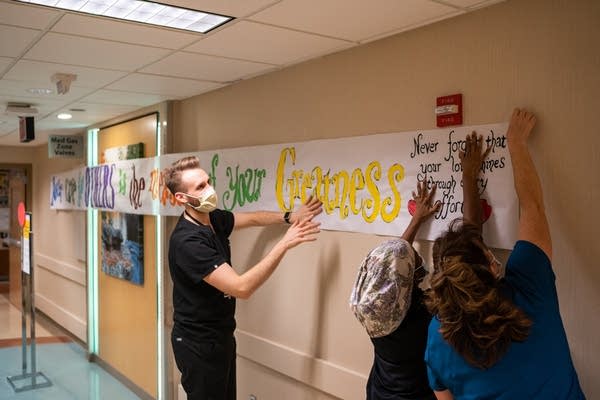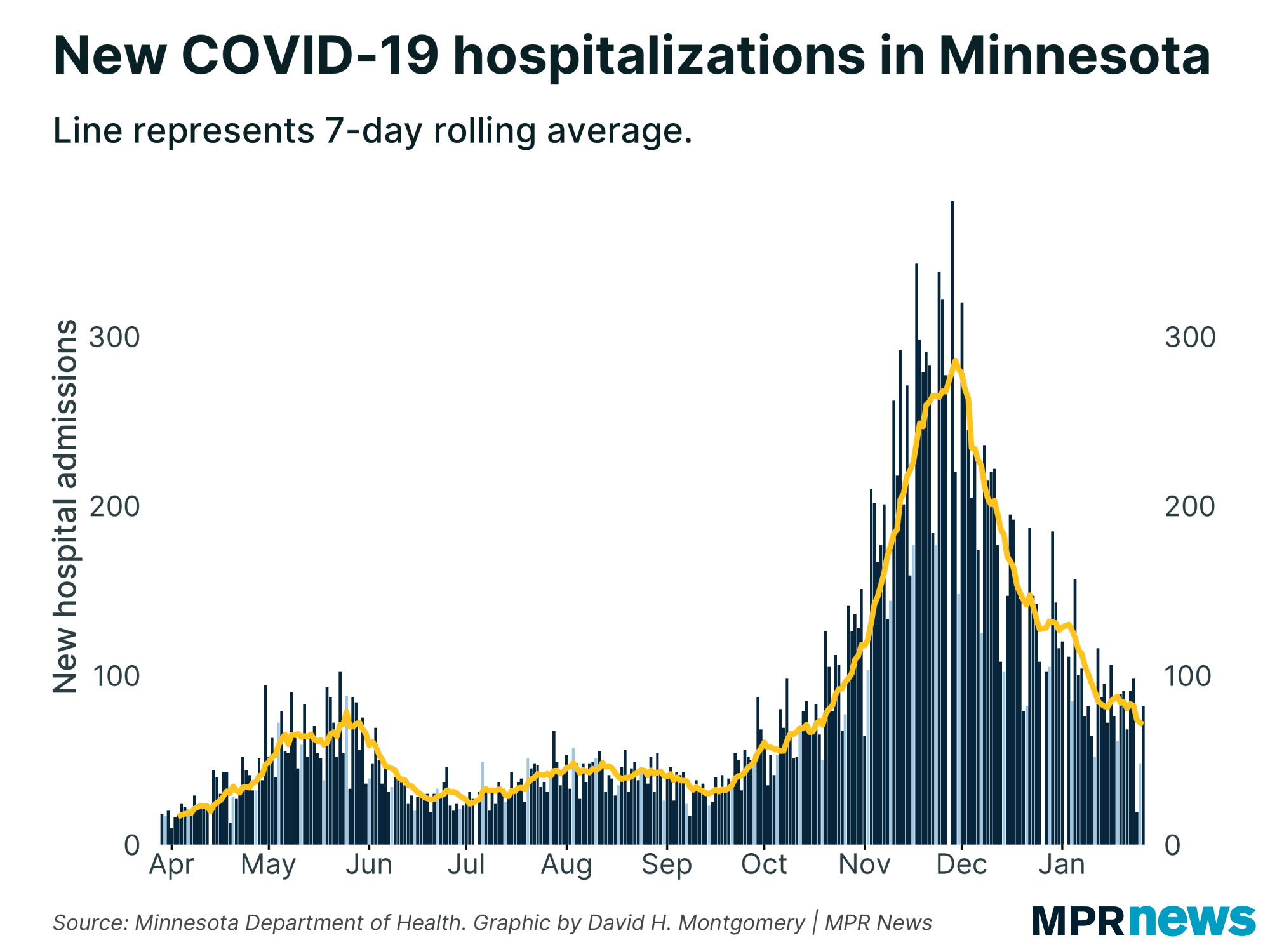Jan. 14 update on COVID-19 in MN: State expands vaccination pool; more vaccine needed

Go Deeper.
Create an account or log in to save stories.
Like this?
Thanks for liking this story! We have added it to a list of your favorite stories.
Updated: 4 p.m.
State health leaders on Thursday said hospitals and other heath care providers can now vaccinate a wider group of Minnesotans for COVID-19, including those age 65 and older.
The move allows providers with available vaccine to get it into arms as quickly as possible and to “make sure they have nothing holding them back,” Health Commissioner Jan Malcolm told reporters.
At the same time, Malcolm said that the state needs to receive more vaccine from federal authorities to make the broader eligibility work. She emphasized that those in the expanded pool should not been rushing to make vaccination appointments.
The new guidance to hospitals and other sites was done simply to remove any barriers to providers that have been vaccinating health care workers and other priority populations and still have some vaccine available.
Turn Up Your Support
MPR News helps you turn down the noise and build shared understanding. Turn up your support for this public resource and keep trusted journalism accessible to all.
“We’re talking about small numbers of doses that some health care providers and agencies have told us” they could use if they got state authorization, she said.
“We are not yet ready to advise large groups of Minnesotans on how they can get vaccine,” she added.
Trump administration officials on Tuesday had urged states to immediately expand eligibility to people 65 and older as well as people deemed especially susceptible to the disease. State leaders applauded that announcement but noted that the feds needed to follow through with the vaccine shipments to make it happen.
“The reality is we have far more Minnesotans eligible for getting the vaccine than we have doses available from the federal government,” Malcolm said Thursday. “We have been working to get ready and we are ready to get more vaccines out quickly, but now we really need for the federal government to step up and provide us with additional supply of vaccine to make that possible."
About 430,000 doses have been shipped to Minnesota so far to health providers and the federal program for long-term care facility vaccinations, according to the state’s new COVID-19 vaccination dashboard website; more than 150,000 Minnesotans have received at least one dose so far.
Malcolm said the state expected to release more details in coming days about vaccination eligibility and supply.
Moderate cases, hospitalizations
Malcolm’s remarks came hours after her department released data showing relatively positive trend lines for Minnesota on a bunch of key COVID-19 measures, including new cases and hospitalizations.
The Health Department reported 1,598 newly confirmed or probable cases of the disease — along with 43 more deaths; 645 people were in the hospital with COVID-19, with 131 needing intensive care.
Those hospitalization counts have dropped by more than half over the past four weeks. The seven-day trend of new hospital admissions is down to levels not seen since late October. Hospital admissions are now lower than they were on Nov. 1, but still above their Oct. 1 level.

While the improving trends look good following an awful November and December — when cases, hospitalizations and deaths spiked — officials still don’t believe the state is in the clear. Public health leaders believe another surge is likely in the coming weeks following the year-end holidays.
Gov. Tim Walz said in mid-December his COVID-19 watchers were worried about a February spike. On Monday, Health Commissioner Jan Malcolm braced Minnesotans to see daily death and case counts trending higher again.
Active, confirmed case counts are trending up slightly.

“We do expect to see cases go back up in Minnesota following the year-end holidays, and potentially just as a result of the winter wearing on and more indoor time and more gatherings,” Malcolm told reporters.
The cases reported Thursday put Minnesota at 441,935 in the pandemic. Of those, about 95 percent have recovered to the point they no longer need to be isolated.

The newly reported deaths raised Minnesota’s toll to 5,817. Among those who’ve died, about 64 percent had been living in long-term care or assisted living facilities; most had underlying health problems.

Cases spread across age groups, regions
People in their 20s still make up the age bracket with the state’s largest number of confirmed cases — more than 84,000 since the pandemic began, including more than 44,000 among people ages 20 to 24.

The number of high school-age youth confirmed with the disease has also grown, with more than 34,000 total cases among those ages 15 to 19 since the pandemic began.
Although less likely to feel the worst effects of the disease and end up hospitalized, experts worry youth and young adults will spread it to older relatives and members of other vulnerable populations.
It’s of particular concern because people can have the coronavirus and spread COVID-19 when they don’t have symptoms.
A relatively small bump in new cases has been happening across the state.

Hot spots continue to pop up in rural counties relative to their population.

Caseloads still heaviest among people of color
In Minnesota and across the country, COVID-19 has hit communities of color disproportionately hard in both cases and deaths. That’s been especially true for Minnesotans of Hispanic descent for much of the pandemic.

Even as new case counts ease from their late November, early December peaks, the data shows people of color continue to be hit hardest.
Distrust of the government, together with deeply rooted health and economic disparities, have hampered efforts to boost testing among communities of color, officials say, especially among unauthorized immigrants who fear their personal information may be used to deport them.
Similar trends have been seen among Minnesota’s Indigenous residents. Counts among Indigenous people jumped in October relative to population.
‘Still in a high-risk situation’
Although the overall conditions have improved significantly in Minnesota over the past two weeks, state public health leaders continue to implore people to wear masks in indoor public gathering spaces, socially distance and take other measures to help stem the spread of COVID-19.
The state last week said it has confirmed five cases of the new, more-contagious coronavirus variant in the Twin Cities metro area. The variant was first detected in the United Kingdom and has since been confirmed in several other U.S. states. It has not been found to cause more-serious cases of COVID-19.
“While our trends have stabilized, we are still in a high-risk situation, and this variant is a major unknown as to what it will do here,” Malcolm said Thursday.
Developments around the state
Inflammatory illness tied to COVID ID’d in 56 MN kids
A worrisome inflammatory condition believed to be related to COVID-19 has surfaced in 56 Minnesota children since the pandemic began, state epidemiologist Dr. Ruth Lynfield said Thursday
While the condition, multi-system inflammatory syndrome, has been deadly in New York, the Minnesota children affected have all survived, although some have required intensive care.
Minnesota is seeing more cases now than last fall, Lynfield told reporters.
While the count is small — 56 out of more than 72,000 COVID-19 cases confirmed in children ages 19 and younger — the inflammatory condition has disproportionately hit children of color harder. Sixty percent of the Minnesota cases identified were Black or Latino children, Lynfield said.
— MPR News Staff
MN to remain in peacetime emergency for at least another 30 days
The state will remain in a peacetime emergency posture for at least another 30 days.
Gov. Tim Walz has extended his COVID-19 executive authority with approval of a council of state officeholders. The declaration he first issued last March has enabled his administration to manage the pandemic response. But it has also riled critics who say he should consult the Legislature more directly.
While there has been some recent improvement in coronavirus trends here, Health Commissioner Jan Malcolm said risks remain.
“The conditions remain very fragile and volatile. Certainly we could see and frankly expect to see continued increase in cases as economic activity and social interactions pick up a bit," Malcolm said.
— Brian Bakst | MPR News
Top headlines
Minn. lawmakers to Walz — where are the shots? Minnesota legislators are pressing state officials to speed up Minnesota’s COVID-19 vaccinations. Gov. Tim Walz says kinks in the federally managed distribution system are the main holdup.
As children's museums reopen, will most families come back? COVID-19 has upended how children's museums operate. The pandemic has forced many of them to temporarily close, including the state's largest children's museum in St. Paul. After a seven-week hiatus, however, the museum reopens Thursday.
Schools are poised to reopen, but teachers aren’t vaccinated: Teachers from some of the state’s largest school districts are voicing concerns about the return to in-person instruction, noting that they have yet to be vaccinated at a time when the COVID-19 virus is still spreading.
COVID-19 in Minnesota
Data in these graphs are based on the Minnesota Department of Health's cumulative totals released at 11 a.m. daily. You can find more detailed statistics on COVID-19 at the Health Department website.


